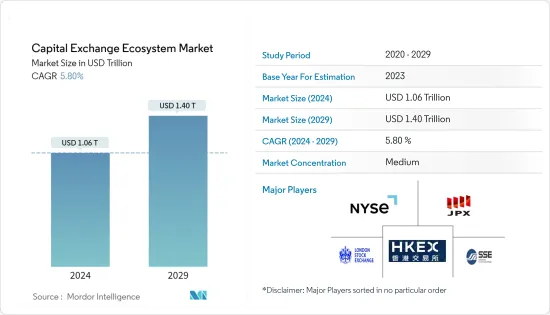
|
市場調査レポート
商品コード
1431564
キャピタルエクスチェンジエコシステム:市場シェア分析、業界動向・統計、成長予測(2024年~2029年)Capital Exchange Ecosystem - Market Share Analysis, Industry Trends & Statistics, Growth Forecasts (2024 - 2029) |
||||||
カスタマイズ可能
適宜更新あり
|
|||||||
| キャピタルエクスチェンジエコシステム:市場シェア分析、業界動向・統計、成長予測(2024年~2029年) |
|
出版日: 2024年02月15日
発行: Mordor Intelligence
ページ情報: 英文 150 Pages
納期: 2~3営業日
|
全表示
- 概要
- 目次
キャピタルエクスチェンジエコシステムの市場規模は2024年に1兆600億米ドルと推定・予測され、2029年には1兆4,000億米ドルに達し、予測期間中(2024-2029年)のCAGRは5.80%で成長すると予測されます。

キャピタルエクスチェンジ市場は、個人、企業、政府の資金調達ニーズを満たすために開発されました。資金は一般に、株式、債券、負債証券、債券、ETFなどの資金調達手段の取引を通じて調達されます。資本市場は、株式市場、債券市場、オプション市場などの証券取引所に設けられています。投資家は企業の株式や債券に資金を投じ、資金の供給者と資金を必要とする人々との橋渡しをします。株式や投資信託には市場リスクがあり、投資をめぐってリスクが発生し、収入の妨げになります。
2020年初頭にCOVID-19が登場し、主要経済圏で大規模なロックダウンが実施されたことで、証券取引所の市場指数は継続的な変動を観測し、リテール・レベルでわずかな利益を得るために資金を投資している人々がいます。
COVID-19の間、企業が提供する株式のリターンや配当は継続的に増加し、COVID-19の間に企業は大規模なレイオフを行い、より多くの株式を放出することで市場価値を増加させました。COVID-19以降、経済は正常化し始め、インフレ率の上昇と金融収縮政策が相まって成長が鈍化し、配当も減少しました。
キャピタルエクスチェンジエコシステムの市場動向
キャピタルエクスチェンジエコシステム市場に影響を与える証券取引所指数の増加
COVID-19の登場により、主要証券取引所の株価は世界的に下落しました。NYSE(ニューヨーク証券取引所)の場合、2019年11月に指数値は2,447.01となり、ロックダウンや経済規制により継続的に低下し、2020年3月には1,536.99に達しました。2020年以降、市場シナリオの変化とさらなる思惑により、株価指数は上昇しました。ダウ工業株30種平均も同様の動向でした。この動向に伴い、株価が下落すると、人々は株価の下落に伴い、より多くの資金を市場に投入し始めました。経済の選択肢が増え、世界の需要を満たすためにサプライチェーンの抜け穴が修正されたため、プラスの成長が観察されました。この継続的なバブルで、株価全体の主要指数は最高レベルに達した後、減少し始めました。
銀行の実質金利がマイナスになり、資本市場の為替エコシステムに影響を与えました。
銀行金利の低下と金融緩和政策によって世界のインフレ率が上昇し続け、預金金利がインフレ率を下回るようになった。
インフレ率と中央銀行金利の間には、中国を除いてすべての国で大きな開きがあり、インフレ率が銀行金利をリードしています。中国の2022年1月のインフレ率は0.9%で、中央銀行の金利は3.7%であり、緩和的な金融政策を採用している他のすべての国とは正反対の金融政策の後退を示しています。
資本交換エコシステム業界の概要
企業が投資のために世界に資本を増やすと、資本が必要になります。株式の発行は、株主の収益が企業全体の価値変動に依存する企業にとって、資本を調達する最も簡単な方法です。世界市場における株式発行総数は、継続的にプラス成長を続けています。この株式発行動向の増加に伴い、株式価値も成長し、投資のための積極的な市場が形成され、より多くの人々が投資し、会社の株式を購入するようになった。
その他の特典:
- エクセル形式の市場予測(ME)シート
- 3ヶ月間のアナリスト・サポート
目次
第1章 イントロダクション
- 調査の前提条件と市場定義
- 調査範囲
第2章 調査手法
第3章 エグゼクティブサマリー
第4章 市場力学
- 市場概要
- 市場促進要因
- あらゆるプロセスの自動化
- 規制状況
- 市場抑制要因
- 資本規制による成長鈍化
- 市場機会
- バリューチェーン全体の多様化
- ポーターのファイブフォース分析
- 買い手/消費者の交渉力
- 供給企業の交渉力
- 新規参入業者の脅威
- 代替品の脅威
- 競争企業間の敵対関係の強さ
第5章 市場セグメンテーション
- 市場構成
- 第一次
- 第二次
- 資本市場
- 株式
- 債券
- 株式タイプ
- 普通株と優先株
- 成長株
- バリュー株
- ディフェンシブ株
- 債券タイプ
- 政府債
- 社債
- 地方債
- 住宅ローン
- その他の債券
第6章 競合情勢
- 企業プロファイル
- New York Stock Exchange
- Japan Exchange Group
- London Stock Exchange
- HongKong Stock Exchange
- Shanghai Stock Exchange
- National Stock Exchange
- EURONEXT
- NASDAQ
- Bombay Stock Exchange
- Saudi Stock Exchange*
第7章 市場機会と今後の動向
第8章 免責事項
The Capital Exchange Ecosystem Market size is estimated at USD 1.06 trillion in 2024, and is expected to reach USD 1.40 trillion by 2029, growing at a CAGR of 5.80% during the forecast period (2024-2029).

Capital Market exchanges are developed to satisfy the need to raise funds for individuals, firms and governments. The fund is generally raised through trading of funding instruments such as shares, debentures, debt instruments, bonds, ETFs, etc. Capital markets are established in stock exchanges such as the equity, debt, and options markets. Investors invest money in a firm's share or bond, bridging the gap between suppliers of capital and people in need of money. With market risk in shares and mutual funds, risk occurs over one's investment and hinders income.
With the advent of COVID-19 in early 2020 and major lockdowns being placed in major economy stock exchange market index observed continuous fluctuations with people investing money for small gains at the retail level.
Returns and dividends of stocks provided by companies observed continuous growth during COVID-19, with companies doing a large layoff during COVID-19 and increasing their market value by releasing more stocks. After COVID-19, the economy started normalizing, and an increase in inflation combined with contractionary monetary policy caused a slowdown in growth and a reduction in dividends.
Capital Exchange Ecosystem Market Trends
Increasing Stock Exchanges Index affecting Capital Market Exchange Ecosystem
With the advent of the COVID-19 index value of major stock exchanges declined globally. For NYSE (New York Stock Exchange), on November 2019, the index value stood at 2,447.01, continuously declining with lockdowns and economic restrictions, reaching 1,536.99 on March 2020. After 2020 with a change in the market scenario and further speculations, stock Index value increased. Similarity Dow Jones Industrial Average observed a similar trend. With this trend, as the stock price declined, people started placing more money in the market with declining stock price. Positive growth was observed as economy options and for meeting global demand loopholes in the supply chain were fixed. With this continuous bubbling, stock price overall major index started to decline after reaching their highest level.
Negative Real Interest rake in Banking affecting Capital Market Exchange Ecosystem.
As global inflation had observed a continuous increase with a decline in the interest rate of banks and accommodative policies, earning through interest rate on deposits had fallen below the rate of inflation; this trend had caused a lot of people to invest in Global Capital Market for achieving a higher level of interest rate.
A significant gap exists between all the countries between inflation rate and central bank interest rate, with the inflation rate leading the bank interest rate except for China. In China, during January 2022 inflation rate exists at 0.9%, with the central bank interest rate at 3.7%, showing a restrive monetary policy opposite to all other nations adopting accommodative monetary policy.
Capital Exchange Ecosystem Industry Overview
As firms increase their capital globally for their investments, they need capital. Issuing shares is the easiest method for firms to raise capital where shareholders' earning depends on an overall company value change. The total number of shares issued in global markets has observed continuous positive growth. With this increase in share issue trend value of equity had also observed growth, creating a positive market for investment and attracting more people to invest and buy company shares.
Additional Benefits:
- The market estimate (ME) sheet in Excel format
- 3 months of analyst support
TABLE OF CONTENTS
1 INTRODUCTION
- 1.1 Study Assumptions and Market Definition
- 1.2 Scope of the Study
2 RESEARCH METHODOLOGY
3 EXECUTIVE SUMMARY
4 MARKET DYNAMICS
- 4.1 Market Overview
- 4.2 Market Drivers
- 4.2.1 Automating all processes
- 4.2.2 Regulatory Landscape
- 4.3 Market Restraints
- 4.3.1 Capital restrictions can slow down growth
- 4.4 Market Opportunities
- 4.4.1 Diversification across the value chain
- 4.5 Porter's Five Forces Analysis
- 4.5.1 Bargaining Power of Buyers/Consumers
- 4.5.2 Bargaining Power of Suppliers
- 4.5.3 Threat of New Entrants
- 4.5.4 Threat of Substitute Products
- 4.5.5 Intensity of Competitive Rivalry
5 MARKET SEGMENTATION
- 5.1 Market Composition
- 5.1.1 Primary
- 5.1.2 Secondary
- 5.2 Capital Market
- 5.2.1 Stocks
- 5.2.2 Bonds
- 5.3 Stock Type
- 5.3.1 Common and Preferred
- 5.3.2 Growth Stock
- 5.3.3 Value Stock
- 5.3.4 Defensive stock
- 5.4 Bond Type
- 5.4.1 Government
- 5.4.2 Corporate
- 5.4.3 Municiple
- 5.4.4 Mortgage
- 5.4.5 Other Bond Types
6 COMPETITIVE LANDSCAPE
- 6.1 Overview (Market Concentration and Major Players)
- 6.2 Company Profiles
- 6.2.1 New York Stock Exchange
- 6.2.2 Japan Exchange Group
- 6.2.3 London Stock Exchange
- 6.2.4 HongKong Stock Exchange
- 6.2.5 Shanghai Stock Exchange
- 6.2.6 National Stock Exchange
- 6.2.7 EURONEXT
- 6.2.8 NASDAQ
- 6.2.9 Bombay Stock Exchange
- 6.2.10 Saudi Stock Exchange*

